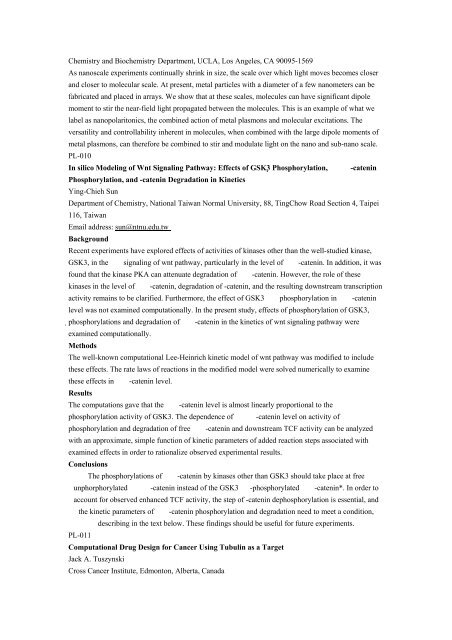Abstracts Keynote & Plenary
Abstracts Keynote & Plenary
Abstracts Keynote & Plenary
You also want an ePaper? Increase the reach of your titles
YUMPU automatically turns print PDFs into web optimized ePapers that Google loves.
Chemistry and Biochemistry Department, UCLA, Los Angeles, CA 90095-1569<br />
As nanoscale experiments continually shrink in size, the scale over which light moves becomes closer<br />
and closer to molecular scale. At present, metal particles with a diameter of a few nanometers can be<br />
fabricated and placed in arrays. We show that at these scales, molecules can have significant dipole<br />
moment to stir the near-field light propagated between the molecules. This is an example of what we<br />
label as nanopolaritonics, the combined action of metal plasmons and molecular excitations. The<br />
versatility and controllability inherent in molecules, when combined with the large dipole moments<br />
of<br />
metal plasmons, can therefore be combined to stir and modulate light on the nano and sub-nano scale.<br />
PL-010<br />
In silico Modeling<br />
of Wnt Signaling Pathway: Effects of GSK3� Phosphorylation, -catenin<br />
Phosphorylation, and -catenin Degradation in Kinetics<br />
Ying-Chieh Sun<br />
Department of Chemistry,<br />
National Taiwan Normal University, 88, TingChow Road Section 4, Taipei<br />
116, Taiwan<br />
Email address: sun@ntnu.edu.tw<br />
Background<br />
Recent experiments have explored effects of activities of kinases other than the well-studied kinase,<br />
GSK3, in the signaling of wnt pathway, particularly in the level of -catenin. In addition, it was<br />
found that the kinase PKA can attenuate degradation of -catenin. However, the role of these<br />
kinases in the level of -catenin, degradation of -catenin, and the resulting downstream transcription<br />
activity remains to be clarified. Furthermore, the effect of GSK3 phosphorylation in -catenin<br />
level was not examined computationally. In the present study, effects of phosphorylation of GSK3,<br />
�phosphorylations and degradation of -catenin in the kinetics of wnt signaling pathway were<br />
examined computationally.<br />
Methods<br />
The well-known<br />
computational Lee-Heinrich kinetic model of wnt pathway was modified to include<br />
these effects. The rate laws of reactions in the modified model were solved numerically to examine<br />
these effects in -catenin level.<br />
Results<br />
The computations<br />
gave that the -catenin level is almost linearly proportional to the<br />
phosphorylation activity of GSK3. The dependence of -catenin level on activity of<br />
phosphorylation and degradation of free -catenin and downstream TCF activity can be analyzed<br />
with an approximate, simple function of kinetic parameters of added reaction steps associated with<br />
examined effects in order to rationalize observed experimental results.<br />
Conclusions<br />
The phosphorylations<br />
of -catenin by kinases other than GSK3 should take place at free<br />
unphorphorylated -catenin instead of the GSK3 -phosphorylated -catenin*. In order<br />
to<br />
account for observed enhanced TCF activity, the step of -catenin dephosphorylation is essential, and<br />
the kinetic parameters of -catenin phosphorylation and degradation need to meet a condition,<br />
describing in the text below. These findings should be useful for future experiments.<br />
PL-011<br />
Computational<br />
Drug Design for Cancer Using Tubulin as a Target<br />
Jack A. Tuszynski<br />
Cross Cancer Institute,<br />
Edmonton, Alberta, Canada












